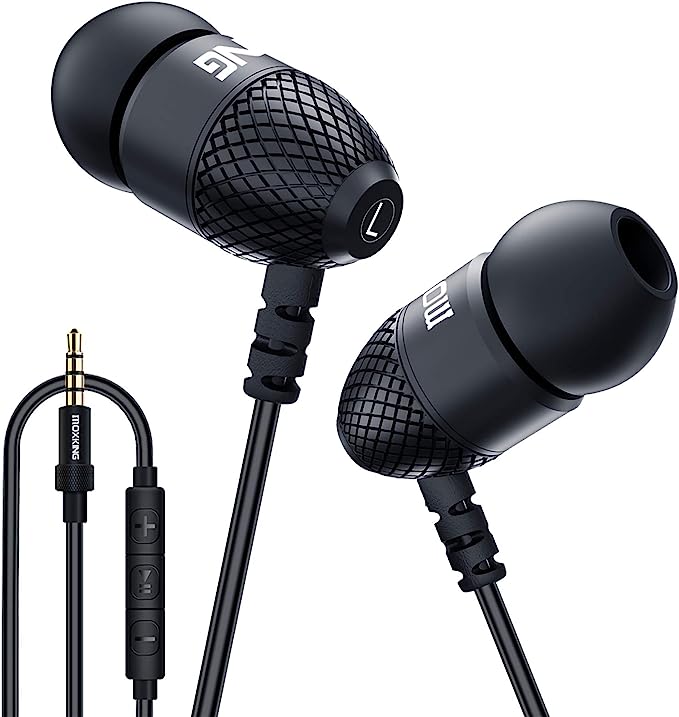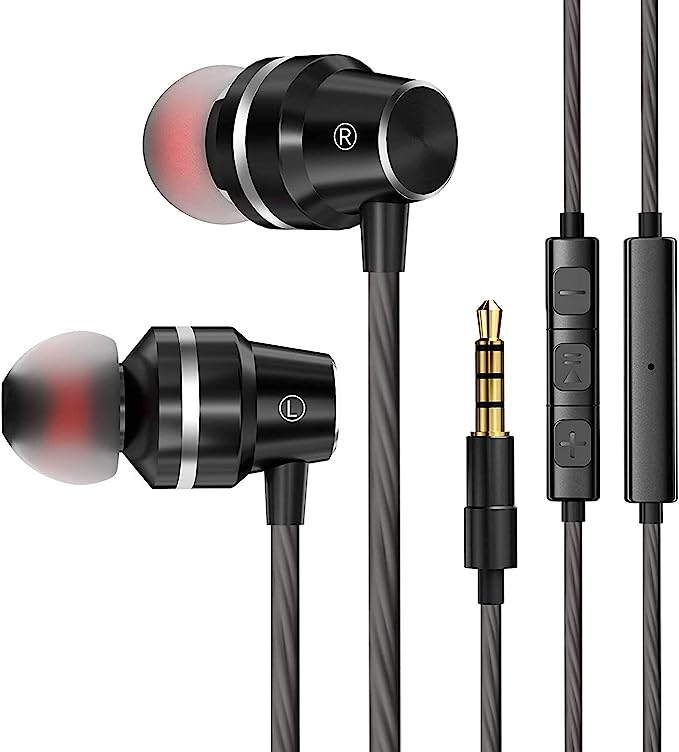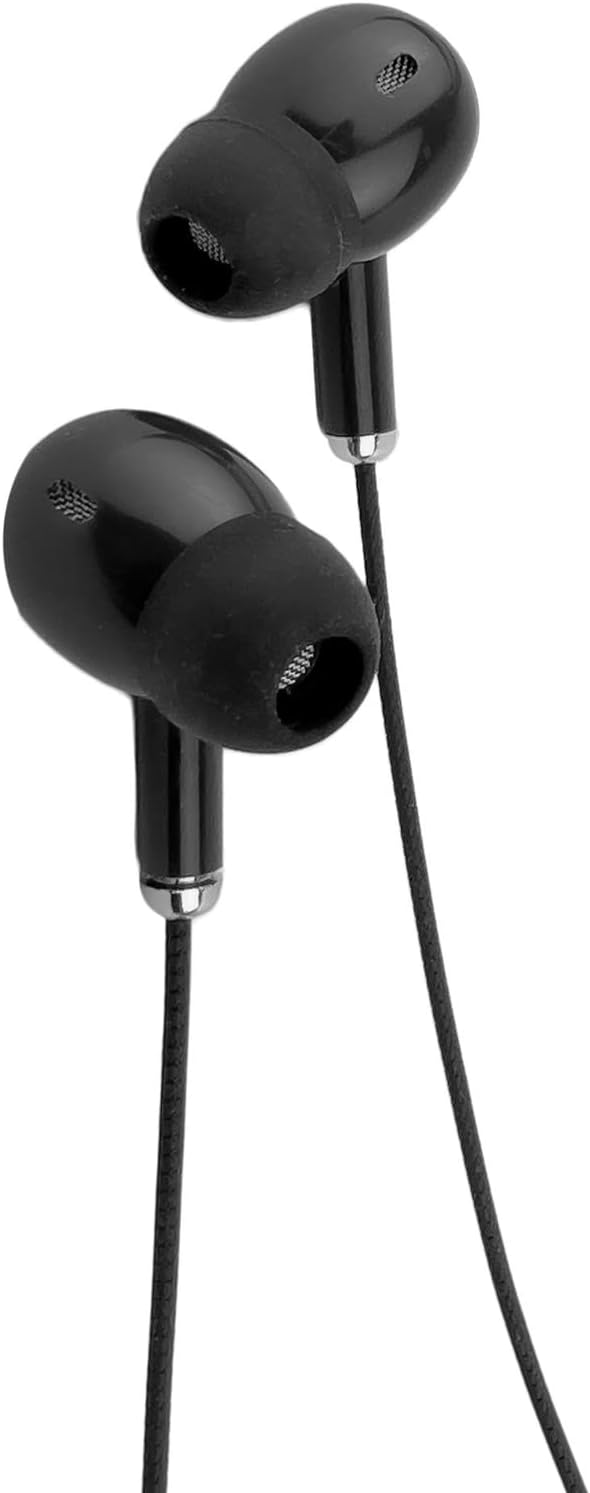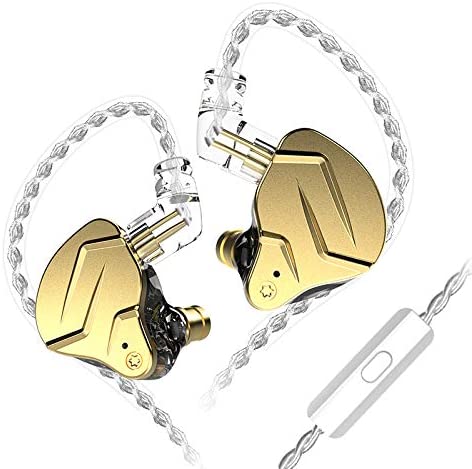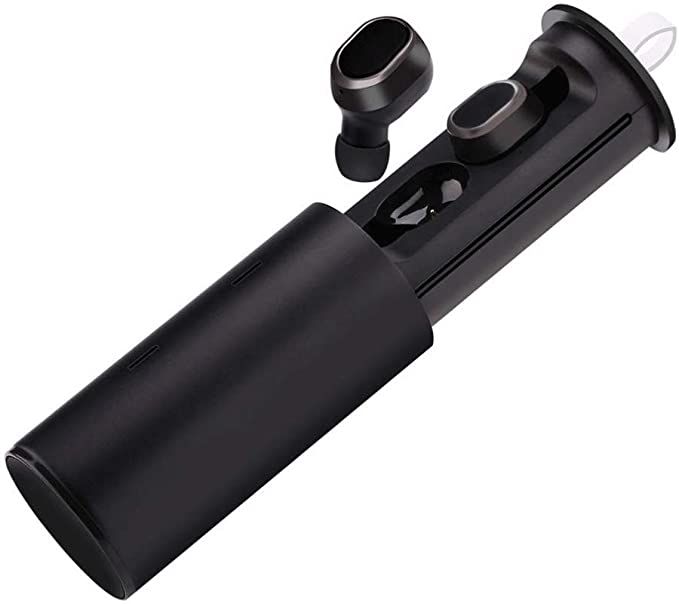FiiO FF3 Earbuds: Unveiling the Alchemy of Sound – A Deep Dive into Audio Science
Update on June 20, 2025, 5:38 p.m.
The Alchemist’s Pursuit of Sound: Deconstructing the FiiO FF3 Earbuds
In our relentless quest for a connection to the raw, unvarnished soul of music, the tools we use to listen become profoundly important. Why are we so captivated by sound, and from where does truly “good” sound originate? The FiiO FF3 wired earbuds invite us on such an exploration. They are more than mere conduits of audio; they present themselves as a meticulously engineered “sound laboratory,” a testament to the idea that exceptional audio is born from a sophisticated interplay of material science and acoustic engineering – a kind of modern-day alchemy. This journey will delve into the scientific crucible where the FF3’s high-resolution auditory experience is forged, examining the very elements – its driver, its cable, its connectivity, and its design – that contribute to its sonic signature.

The Heart of the Sonic Engine: Unveiling the 14.2mm Beryllium-Plated Dynamic Driver
At the core of any earphone’s ability to transform an electrical signal into the rich tapestry of sound lies its driver. The FiiO FF3 employs a single dynamic driver, a technology with a storied history, yet one that FiiO has imbued with contemporary innovations.
Think of a dynamic driver as a miniature, precision loudspeaker. An electrical audio signal, carrying the complex waveforms of music, flows through a finely wound voice coil. This coil is intimately attached to a diaphragm – a thin, responsive membrane – and is suspended within a powerful magnetic field. As the electrical current undulates, it generates a fluctuating magnetic force, compelling the coil and diaphragm to vibrate in perfect synchrony with the original audio. These vibrations displace the surrounding air, creating pressure waves that our ears and brain miraculously interpret as melodies, harmonies, and rhythms.
The FF3 houses a substantial 14.2mm dynamic driver. In the world of miniature transducers, size does matter. A larger diaphragm surface area, like the FF3’s “engine,” can move a greater volume of air with each oscillation. This is fundamentally crucial for reproducing the visceral impact of deep bass frequencies – those notes you feel as much as hear. Furthermore, a larger driver can often support more complex vibrational modes, potentially contributing to a more open, three-dimensional sound presentation, often described by audiophiles as a wider “soundstage.” It’s akin to the difference between a small drum and a large one; the larger drum inherently produces a deeper, more resonant tone and can fill a larger space with sound.
But size alone isn’t the whole story. The true “alchemy” begins with the diaphragm’s material composition. Conventional diaphragm materials, often plastics like PET (Polyethylene terephthalate) or PEN (Polyethylene naphthalate), while cost-effective and functional, have inherent limitations. They can be prone to “break-up” or “分割振动” (segmental vibration) at higher frequencies or during rapid, complex passages. This means different parts of the diaphragm might vibrate out of sync, leading to a loss of clarity, added distortion, and a smearing of fine details.
Enter beryllium. The FF3’s diaphragm features a beryllium-plated dome, and this choice is pivotal. Beryllium is an elemental marvel in the world of acoustics. It possesses a paradoxical combination of properties: it is extraordinarily lightweight (its density is about 30% less than aluminum) yet phenomenally rigid (its Young’s modulus, a measure of stiffness, is significantly higher than that of steel or titanium). This exceptional stiffness-to-weight ratio is the holy grail for diaphragm designers. It allows the beryllium-plated dome to move as a near-perfect piston, even under a barrage of high-frequency signals or sudden, intense transients. Imagine a perfectly crafted tuning fork; when struck, it vibrates at a precise frequency, producing a pure, unwavering tone. A beryllium dome strives for this level of pistonic motion, resisting the tendency to flex or deform.
The scientific payoff is immense. This rigidity and low mass enable a lightning-fast transient response – the ability to precisely start and stop with the music, capturing the sharp attack of a snare drum, the delicate pluck of a guitar string, or the subtle decay of a piano note with uncanny accuracy. It translates to astonishing detail retrieval, unearthing nuances in recordings that might be lost with lesser materials. And crucially, it leads to significantly reduced distortion, as the diaphragm maintains its shape and moves uniformly, ensuring the sound produced is a faithful replica of the electrical input.
However, a super-rigid dome needs a compliant partner to allow for the necessary movement, especially for lower frequencies. This is where the PU (Polyurethane) gasket or surround comes into play. This flexible yet durable material forms the edge of the diaphragm, allowing the beryllium-plated dome the freedom for linear excursion – the back-and-forth travel needed to generate those satisfying, deep bass notes without buckling or restricting movement. The PU surround also helps to damp any unwanted resonances that might emanate from the edge of the dome assembly, further contributing to a cleaner sound.
Thus, the beryllium-plated dome, supported by its PU gasket, becomes a cornerstone of the FF3’s claim to “high-resolution” audio. It’s a testament to how the careful selection and application of advanced materials can elevate sound reproduction from mere functionality to an art form, allowing us to hear deeper into the music.

The Lifeline of Fidelity: Decoding the FF3’s High-Performance Cable and Connection Wizardry
In an era increasingly dominated by wireless convenience, the humble wired connection tenaciously holds its ground among discerning listeners. Why? Because a well-engineered cable offers the potential for uncompromised signal integrity, a direct, untainted pathway from your audio source to your ears. The FiiO FF3 demonstrates a clear commitment to this principle, investing considerable thought into its cable and connectivity.
The journey of the audio signal from your device to the FF3’s drivers is through its high-performance cable, a component often underestimated but critical for preserving sonic purity. The FF3’s cable is constructed from high-purity silver-plated monocrystalline copper. Let’s break down this alchemical concoction:
- Monocrystalline Copper: At its heart, copper is an excellent electrical conductor. However, standard copper wires are polycrystalline, meaning they are composed of many small crystal grains. The boundaries between these grains can act as tiny “roadblocks” or points of impedance for the delicate audio signal, causing minute reflections, losses, and distortions. Monocrystalline copper, as the name suggests, is formed in such a way as to create long, continuous crystal structures, drastically reducing these grain boundaries. The result is a smoother, more unimpeded path for the electrical current, translating to a cleaner, more transparent sound with fewer signal-degrading artifacts.
- Silver-Plating: Silver boasts even higher electrical conductivity than copper. In audio cable design, a thin layer of silver is often plated onto copper conductors. This is particularly beneficial due to a phenomenon known as the “skin effect.” At higher audio frequencies, the electrical current tends to concentrate and travel along the surface, or “skin,” of the conductor. Since silver offers a more conductive pathway than copper, this silver plating effectively creates a “superhighway” for these high-frequency components of the music. FiiO states that this “improves treble resolution while reducing unwanted sibilance.” Enhanced treble resolution means more clarity, detail, and “air” in the upper registers. The claim about reducing sibilance (the harshness sometimes heard in ‘s’ or ‘t’ sounds) could be attributed to a smoother, more controlled high-frequency response curve facilitated by the silver plating, preventing sharp peaks that might exacerbate sibilant tendencies in certain recordings.
- The 152-Wire Ensemble: The FF3’s cable isn’t just a single strand; it comprises a total of 152 individual, fine wires. This multi-strand (or Litz-like) construction offers several advantages. It increases the overall conductor surface area (tying back to the skin effect for high frequencies) and enhances the cable’s flexibility and durability compared to a solid-core wire of equivalent gauge. It can also help in reducing the overall impedance of the cable, ensuring more of the audio signal’s power reaches the drivers.
The connection to your audio source is just as critical. The FF3 features an ingenious all-aluminum twist-lock swappable plug system. This isn’t just a convenience; it’s a nod to versatility and a commitment to quality connection. Users can effortlessly switch between:
- The 3.5mm Single-Ended Jack: This is the ubiquitous standard, found on countless smartphones, laptops, portable music players, and tablets. Its inclusion ensures broad compatibility for everyday listening.
- The 4.4mm Balanced Output Jack: This larger, more robust connector is increasingly favored in high-fidelity portable and desktop audio gear. It facilitates a balanced audio connection. What does “balanced” mean in this context? In a typical 3.5mm single-ended connection, the left and right audio channels share a common ground wire. In a balanced system, like that enabled by the 4.4mm plug, each channel (left and right) has two dedicated signal paths – a positive (+) phase and a negative (-) phase – plus a separate ground for each, or a system designed to reject common-mode noise. At the amplifier end, the signals are processed differentially. The primary benefit of this approach is common-mode rejection. Any noise or interference picked up equally by both the positive and negative signal wires of a channel is effectively canceled out when the signals are combined at the receiving end. This can lead to a significantly lower noise floor (a “blacker” background), reduced crosstalk (signal leakage between the left and right channels), improved channel separation (a more distinct and spacious stereo image), and often, a perception of wider dynamic range.
The precision-engineered all-aluminum twist-lock mechanism itself ensures a secure, mechanically sound, and electrically reliable connection. There’s no antsy wiggling or fear of accidental disconnection; just a solid click that inspires confidence in the signal path.
Finally, encasing these meticulously crafted conductors is a sheath made of German TPU (Thermoplastic Polyurethane). TPU is renowned for its excellent durability, flexibility, and resistance to abrasion, oils, and environmental factors. This means the FF3’s cable is built to withstand the rigors of daily use, whether coiled in a pocket or draped during an active listening session, all while remaining pliable and resistant to tangling.
Through this carefully considered cable and connection system, the FiiO FF3 endeavors to ensure that the delicate audio signal, rich with musical information, completes its journey from source to driver with the utmost fidelity, laying a critical foundation for the high-resolution sound it aims to deliver.

Classic Form, Acoustic Ingenuity: The Design Philosophy of the FF3
Beyond the intricate electronics and exotic materials, the physical form and ergonomic considerations of an earphone profoundly influence the listening experience. The FiiO FF3 embraces a classic “earbud” style, a design that evokes a sense of nostalgia for many, yet it’s infused with modern acoustic thinking and material choices.
This traditional earbud form factor, which rests gently in the concha (the outer bowl-shaped part of the ear) rather than inserting deeply into the ear canal like In-Ear Monitors (IEMs), offers distinct advantages. For many users, this non-invasive approach translates to superior comfort, especially during extended listening periods. There’s no pressure build-up within the ear canal, and the sensation is often described as more open and less fatiguing. Furthermore, this style typically allows for a degree of situational awareness. Unlike IEMs that aim for maximum noise isolation, earbuds like the FF3 permit some ambient sound to filter through. This can be a significant safety benefit when used outdoors or in environments where being aware of one’s surroundings is crucial. For some, it simply provides a more natural listening experience, preventing the “disconnected” feeling that strong isolation can sometimes induce.
The FiiO FF3’s housings, the shells that encase the precious driver assemblies, are crafted from stainless steel. This isn’t merely an aesthetic choice for a premium look and feel, although it certainly contributes to that. Stainless steel possesses desirable acoustic properties. Its high density and rigidity help to minimize unwanted enclosure resonances. Imagine tapping a flimsy plastic cup versus a solid metal one; the metal one rings less and feels more inert. Similarly, a stainless steel earbud housing is less likely to vibrate sympathetically with the driver or color the sound with its own resonant frequencies. This contributes to a cleaner, more uncolored sound with a “purer” background, allowing the driver to perform its task without interference from its own enclosure. This acoustic inertness is a subtle but important factor in achieving high fidelity.
Further enhancing the user’s ability to tailor the sound is FiiO’s provision of three distinct types of sponge covers: bass-enhancing, balanced, and transparent treble-focused. These unassuming foam pieces are more than just comfort enhancers; they are simple yet effective tools for acoustic micro-tuning. The science here lies in how they modify the acoustic coupling between the earbud and the ear canal. By altering the quality of the seal and the acoustic impedance at this interface, they can subtly shape the perceived frequency response:
- Bass-Enhancing Covers: These likely create a denser, more complete seal around the earbud. In acoustic terms, this increased seal “traps” more low-frequency energy that would otherwise leak out, resulting in a perceived boost in bass quantity and impact.
- Transparent Treble-Focused Covers: FiiO specifically recommends these for “better resolution.” These covers might be made from a more porous foam or incorporate specific perforations. Such a design could allow high-frequency sound waves to diffuse more freely and directly towards the ear canal, minimizing absorption or obstruction by the foam itself, thereby enhancing perceived clarity, detail, and “air” in the treble region.
- Balanced Covers: These aim to provide a neutral acoustic pathway, offering a reference point that attempts to present the earbud’s inherent tuning without significant frequency emphasis.
This ability to subtly customize the sound signature empowers users to adapt the FF3 to their personal preferences or even to different genres of music, adding another layer of thoughtful design.
And sometimes, it’s the simplest touches that underscore a user-focused design philosophy. The FF3 incorporates the classic “Left Blue Right Red” color-coding system, typically on the strain reliefs or a small marking on each earbud. This universally understood convention allows for quick and unambiguous identification of the left and right channels, eliminating fumbling and ensuring the correct stereo image is delivered every time. It’s a small detail, but one that speaks to an understanding of real-world usability.
Through this blend of a time-tested comfortable form factor, the strategic use of acoustically beneficial materials like stainless steel, and the provision for personalized sound tweaking via sponge covers, the FiiO FF3 demonstrates that thoughtful physical design is an integral part of the “alchemy” that creates a truly satisfying listening experience.

Decoding the FF3’s “Sonic DNA”: What the Key Specifications Reveal
Technical specifications, often a string of numbers and symbols, can seem arcane. Yet, they provide a quantitative glimpse into an earphone’s electrical and acoustic characteristics – its “Sonic DNA,” if you will. For the FiiO FF3, key specifications like impedance, sensitivity, and frequency response offer valuable clues about its performance potential and how it might interact with your audio equipment.
-
Impedance (45Ω at 1kHz): Impedance, measured in Ohms (Ω), represents the total opposition an electrical circuit—in this case, the earphone’s driver assembly—presents to the flow of alternating current (the audio signal). An impedance of 45 Ohms places the FF3 in the moderate range. This means that while most modern smartphones, laptops, and portable digital audio players (DAPs) should be able to drive the FF3 to perfectly adequate listening levels, it’s not an extremely low impedance that can be effortlessly driven by virtually any source. To truly unlock the FF3’s full dynamic potential, particularly in terms of bass control and overall authority, pairing it with a source that has a robust amplification stage—like a dedicated DAP with a good headphone output or a portable headphone amplifier—is likely to yield the best results. Think of it like a well-tuned engine; it can run on regular fuel, but premium fuel allows it to perform at its peak.
-
Sensitivity (105dB at 1kHz@1mW): Sensitivity is a measure of an earphone’s efficiency: how effectively it converts electrical power into sound pressure level (SPL), which we perceive as loudness. It’s typically expressed in decibels (dB) of SPL produced when 1 milliwatt (mW) of power is applied, often measured at a standard frequency of 1kHz. A sensitivity rating of 105dB is relatively high. This indicates that the FF3 doesn’t require a large amount of power from your audio source to achieve ample volume. This high efficiency makes them quite versatile, as even devices with modest power output can make them sing loudly and clearly. It means your device’s battery might last a bit longer, and you’re less likely to need to crank the volume dial to maximum.
-
Frequency Response (20Hz - 20kHz): This specification indicates the range of sound frequencies the earphones are designed to reproduce, from the deepest bass notes (measured in Hertz, Hz) to the highest treble shimmer (measured in kilohertz, kHz). The stated range of 20Hz to 20kHz comfortably covers the generally accepted spectrum of human hearing for young, healthy ears. This suggests that the FiiO FF3 is engineered to reproduce all the fundamental frequencies and many of the harmonics present in most musical recordings, from the rumble of a pipe organ’s lowest pedal tones to the delicate overtones of a cymbal crash. (Note: The product page also mentions a 10Hz-20kHz range in “Additional details.” While 10Hz is well below typical human hearing thresholds for distinct pitch, very low frequencies can sometimes be perceived as physical vibration or pressure. The 20Hz-20kHz figure is the more standard and reliably audible claim for full-range reproduction.)
It’s crucial to remember, however, that while these specifications provide a valuable objective baseline, they don’t tell the whole story of how an earphone will actually sound. The true “magic” of audio reproduction lies not just in hitting certain numerical targets, but in the artful science of tuning. This involves countless hours of listening, measuring, and subtly adjusting the interplay of all components—the driver, the housing acoustics, the damping materials, even the eartips or sponge covers—to achieve a desired sonic signature. Two earphones with identical on-paper specifications can sound vastly different due to these tuning choices. Parameters are the foundational building blocks, but the final sonic edifice is a result of skilled engineering and a discerning ear. The FF3’s specifications suggest a solid foundation upon which a high-quality listening experience can be built.
Conclusion: The FF3 – A Symphony of Science, Artistry, and Listening Pleasure
The journey through the FiiO FF3’s design and technological underpinnings reveals a device born from a meticulous fusion of material science, acoustic engineering, and a deep understanding of the listener’s desire for an immersive audio experience. It’s an “alchemical” process where raw elements—beryllium, high-purity silver, monocrystalline copper, stainless steel—are not merely assembled, but are synergistically combined and precisely shaped to serve a singular purpose: the faithful and engaging reproduction of sound.
From the potent 14.2mm dynamic driver, whose beryllium-plated dome promises speed, clarity, and precision, to the sophisticated silver-plated monocrystalline copper cable engineered to preserve every nuance of the audio signal, the FF3 demonstrates a commitment to quality at each stage of the sound’s journey. The inclusion of swappable 3.5mm and 4.4mm balanced plugs speaks to a modern versatility, catering to a wide array of audio sources and unlocking the potential for an even cleaner, more spacious sound with balanced connections. The classic earbud form, rendered in robust stainless steel and customizable with different sponge covers, underscores a philosophy that weds enduring comfort with the ability for personal acoustic tailoring.
The FiiO FF3, therefore, emerges as more than just a pair of wired earbuds. It stands as a contemporary homage to the enduring appeal of the classic audio experience, significantly empowered by advancements in material science and transducer technology. It’s an invitation to listeners: to move beyond passive hearing and engage in active, discerning listening. It’s an opportunity to explore the rich textures, subtle details, and emotional depth that “high-resolution” and “lossless” sound can unveil – to understand and appreciate the profound scientific and artistic effort that culminates in the pure, unadulterated joy that technology can bring to the world of music. The FF3 is a reminder that in the pursuit of auditory gold, the thoughtful application of science can indeed yield treasures for the ear.
